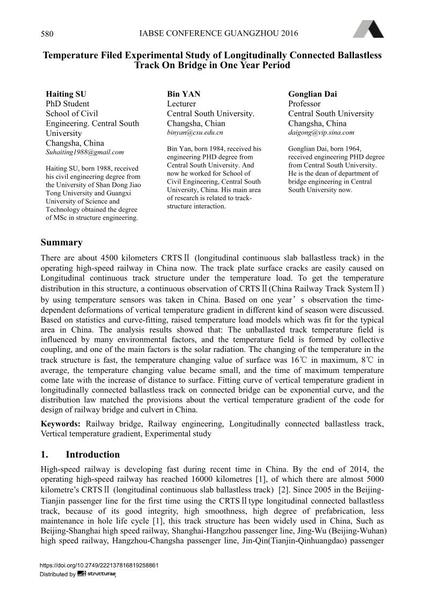Temperature Filed Experimental Study of Longitudinally Connected Ballastless Track On Bridge in One Year Period

|
|
|||||||||||
Bibliographic Details
| Author(s): |
Haiting Su
Bin Yan Gonglian Dai |
||||
|---|---|---|---|---|---|
| Medium: | conference paper | ||||
| Language(s): | English | ||||
| Conference: | IABSE Conference: Bridges and Structures Sustainability - Seeking Intelligent Solutions, Guangzhou, China, 8-11 May 2016 | ||||
| Published in: | IABSE Conference, Guangzhou, China, 8 – 11 May 2016 | ||||
|
|||||
| Page(s): | 580-589 | ||||
| Total no. of pages: | 10 | ||||
| Year: | 2016 | ||||
| DOI: | 10.2749/222137816819258861 | ||||
| Abstract: |
There are about 4500 kilometers CRTSⅡ (longitudinal continuous slab ballastless track) in the operating high-speed railway in China now. The track plate surface cracks are easily caused on Longitudinal continuous track structure under the temperature load. To get the temperature distribution in this structure, a continuous observation of CRTSⅡ(China Railway Track SystemⅡ) by using temperature sensors was taken in China. Based on one year’s observation the time- dependent deformations of vertical temperature gradient in different kind of season were discussed. Based on statistics and curve-fitting, raised temperature load models which was fit for the typical area in China. The analysis results showed that: The unballasted track temperature field is influenced by many environmental factors, and the temperature field is formed by collective coupling, and one of the main factors is the solar radiation. The changing of the temperature in the track structure is fast, the temperature changing value of surface was 16℃ in maximum, 8℃ in average, the temperature changing value became small, and the time of maximum temperature come late with the increase of distance to surface. Fitting curve of vertical temperature gradient in longitudinally connected ballastless track on connected bridge can be exponential curve, and the distribution law matched the provisions about the vertical temperature gradient of the code for design of railway bridge and culvert in China. |
||||
| Keywords: |
experimental study railway bridge Railway engineering Longitudinally connected ballastless track Vertical temperature gradient
|
||||
